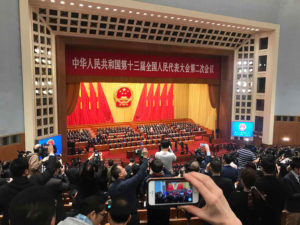On 5th of March, 2019, Premier Li Keqiang delivered the Government Work Report to the second session of the 13th National People’s Congress in Beijing.
Here are the highlights:
1. Corporate burdens
In our previous blogs: Tax in china – Reduction in 2019! and Tax Reduction in China-More Details, we talked about the tax cut policy starting from 1st of Jan, 2019. Further, China aims to reduce the tax burdens and social insurance contributions of enterprises by nearly 2 trillion yuan ($298.3 billion) in 2019, as part of its broader push to promote manufacturing and fuel the growth of small and micro-profit businesses.
The government will deepen the value-added tax reform, reducing the current rate of 16 percent in manufacturing and other industries to 13 percent, and lower the rate in the transportation, construction, and other industries from 10 to 9 percent.
As for social security, the government will cut the proportion of basic endowment insurance units for urban workers, which will be reduced to 16%. The report notes that this year it is important to make the burden of social security contributions for enterprises, especially small and micro-profit enterprises, substantially decline. To this end, all local governments, shall not take the practice of increasing the actual contribution burden of small and micro-profit enterprises, and shall not carry out centralized payment of historical arrears on their own, to ensure stabilization of current mode of payment.

2. Broadband, mobile internet rates
China will further cut the rates for broadband and mobile internet services, as the nation steps up push to nurture innovation and speed up the growth of emerging industries.
This year, average broadband service rates for small and medium enterprises will be lowered by another 15 percent, and average rates for mobile internet services will be further cut by more than 20 percent.
3. High-tech sector
China will continue to upgrade its traditional industries, support the emerging high-tech sector, and increase support for basic and applied research.
The country will strengthen its innovation capabilities, boost the integrated development of advanced manufacturing and modernized services, and create industrial internet platforms to facilitate the transformation and upgrading of manufacturing.
4. Green measures
China will pursue both high-quality development and environmental protection by reforming and refining relevant systems. Green development is a critical element of modernizing an economy and a fundamental solution to pollution.
China plans to reduce sulfur dioxide and nitrogen oxide emissions by 3 percent in 2019, while making continuous effort to decrease the density of PM 2.5, a major particle pollutant, in key locations, including the Beijing-Tianjin-Hebei region, the Yangtze River Delta region and the Fenhe-Weihe River Plain area.
5. Elderly care sector
China will take significant steps to develop the elderly care sector, especially community services, in 2019 as the number of people aged 60 and above has reached 250 million.
The country will provide support to institutions offering services in communities, like day care, rehabilitation, assisted meals and assisted mobility, by using measures such as tax reductions, fee cuts and exemptions, funding support, and reduced charges for water, electricity, gas and heating.
6. Rural students
China will beef up efforts to cut the dropout rates of rural students and improve their college enrollment numbers to stop poverty from passing down to the next generation.
A quota system will also be used to boost attendance of rural students at top universities.
7. Vocational education
The country will take strong moves to develop modern vocational education to help ease current employment pressure and address the shortage of highly skilled personnel.
A vocational skills training initiative will be implemented with 100 billion yuan ($14.9 billion) from the surplus in unemployment insurance funds allocated to provide training for the 15 million targeted attendees, helping job seekers to upgrade skills or switch jobs or industries.
8. Opening-up
China will open more sectors and improve the process of opening-up. The country will continue to promote opening-up based on flows of goods and factors of production, and give greater emphasis to opening-up based on rules and related institutions.
China will continue to push forward China-US trade negotiations. The country is committed to mutually beneficial cooperation and aiming to settle trade disputes through discussions in an equal manner.
9. Employment
China will create more than 11 million new urban jobs this year and keep the urban unemployment rate within 4.5 percent. Multiple channels will be used to achieve stable and expanding employment in 2019.
Having taken prompt steps to ease the impact of changes in the external environment on employment, the central government of China will work to ensure employment for key groups such as college graduates, demobilized soldiers and migrant workers.
Useful link:


